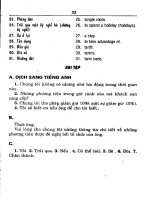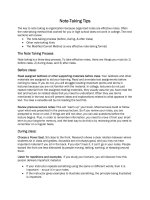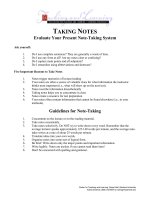Note Taking and Learning A Summary of Research phần 5 pot
Bạn đang xem bản rút gọn của tài liệu. Xem và tải ngay bản đầy đủ của tài liệu tại đây (52.79 KB, 4 trang )
Reading and Note-taking for
Science Students
Academic Skills Unit ● 8344 0930 ● www.services.unimelb.edu.au/asu/
Need to read a number of texts for non-Science subjects?
Many students are increasingly taking classes outside of their field. Science
students sometimes struggle to meet the reading demands of non-specialist
subjects. The brochure provides some study skills and strategies for managing
reading and taking notes.
Planning
A first step is to be sure of your reading requirements. Students are often
unaware that reading lists and recommended reading guides are provided in
most breadth subjects. Before you start your classes and during the semester it
is important that you dedicate time to reading. Some useful strategies are to
• Find your recommended reading list
• Put aside some time to prepare for each tutorial or lecture. A few hours of
reading for each class twice a week will ensure that you maintain focus.
• Draw up a weekly, monthly, or semester-length calendar, mark off time
when you will concentrate on reading.
• Prepare and organize a ‘reading log’. This can be used to calculate the
amount of time you have spend reading. It can be useful to reflect on
your time management, record what exactly you are reading and whether
that is appropriate, as well as a record of achievement.
Feeling ‘lost’
If you find that you are reading articles and cannot understand the point of the
article, you might need to do some foundational reading. Find some generalist
textbooks or books on the subject and read introductory chapters to get a feel
for the subject. A time-saving device might also to read online materials, be
careful though, this material is not usually appropriate to cite or quote in
academic essays. If you are still feeling lost, you might meet with other
students and discuss some of the issues, themes, or ideas raised in required
reading. As a final point of call, you could ask you tutor for additional resources
- 2 -
or guidance. Remember though that the tutor often sets reading tasks for you
to interact and reflect on a text.
Note-taking
Why spend a lot of time reading when you might simply forget? Note-taking is
a crucial tool. As many breadth subjects require students to read widely, it
might not be possible to focus intensively on one or two articles. In this case,
you may start to fall behind. If you are not fully on top of a subject, it might be
because you are not attending to your notes.
Contrary to many students’ expectations, reading does not have to be a dry,
mechanical process. There are many excellent learning skills tools for taking
interesting notes. Educationally, it is worth noting that retention of facts, ideas,
and theories are enhanced by regularly reviewing what you’ve read at different
intervals. This varies from person to person. However, it can be said that
students often benefit from reading, taking notes, and then reviewing a day or
two after, followed by once a week in the following weeks, and then more
infrequent periods in the subsequent months.
Note-taking Strategies
There are many popular strategies for note-taking. These include the SQR3
method, the Cornell Method, and the Coding Method.
SQR3
This method stands for Survey, Question, Read, Recite, Review. Using this approach,
students see reading as distinct stages. It might seem contrived at first but this strategy
helps in developing good reading habits. First, gain an impression of the text – what is it
generally saying? Second, develop questions, or alternatively identify the main
thesis/question in the passage and try and find an answer. Third, closely read the text,
making notes or details. Fourth, recall and recite some of the major points through a written
or verbal summary (helpful in study groups). Finally, review your notes and the reading on a
regular basis, particularly review the major ideas you got from the text.
Cornell Method
This reading approach sees readers divide their page into (usually) three columns. The first
column is for major themes or ideas. A second column is for more detailed points and
examples; a final column is for critical evaluation of the main ideas in the text. This
approach can be done while reading or as part of a review of summary approach. Of course,
it is helpful to identify the major points and review regularly.
- 3 -
Coding Method
A coding method is useful for doing critical evaluations or reviews. By creating a grid (it’s
helpful to use large paper or computer spreadsheet), visual learners are assisted in being
able to make visual connections between research ideas.
Example coding sheet
Author Field/Theory
Method Finding Evaluation
Joyce, J. Feminism Interviews High school girls express an
interest in studying maths and
science in early years of
secondary school in Melbourne
Is the same true in
other cities in
Australia?
Carroll, B. Post-
Modernism
Action
Research
Identity constructions of
scientists in the media has an
effect on schools
Are the same images
presented in school
textbooks?
Murphy,
H.
Positivism Quantitative
methods
Statistical analysis of high
school students performance
on maths test showed stronger
results in inner city suburbs
There were more
scores recorded in
cities than country
high schools. Is this a
problem?
Additional Tips
Reading in breath subjects requires the skill in shifting perspectives,
information triage, and attention to detail. Although there may be hundreds
(sometimes thousands) of articles on a subject in your course, it is worthwhile
to consider some of the following strategies.
• Pay attention to key articles that are mentioned by your lecturer/tutor.
These may be mentioned in lectures, in reading lists, or simply in passing.
Whenever resources are printed and delivered to students, they have
been selected for a reason. Usually because the lecturers believe them to
be excellent, important articles that are going to make you think.
• Look for recent articles. Although many articles may be referred to, the
most recent articles are generally those that express contemporary
thought on a particular subject. Quite often, important earlier readings
may be raised in newer articles, and it is also possible to refer back
yourself. Nevertheless, by reducing your reading load to articles that are
quite new (say in the past 5 years, possibly 10 years), your reading load
is likely to be more focused and less burdensome.
Understand the basic
conceptual framework helps
to gain a sense of the
author’s values.
Identifying research
methods helps you
understand the
findings.
What did the author find
out? Check research
question in introduction
and conclusion
Use a column to add your
own ideas or thoughts eg.
What is missing? Could the
findings be applied to
other groups, contexts
etc
- 4 -
• Use your knowledge of general theories or trends. As within the sciences,
students are required to lean about different fields and debates on
particular topics. In social sciences, the situation is no different. Indeed,
there is likely to be a number of different debates that it is hard to access.
One way is to learn about the major ‘camps’ in your subject and the
general theories behind them. There are a number of over-arching
theories and once you get the hang of them, you have a conceptual
framework to understand details. Coding the different approaches has
been proved effective.
• Check introductions and conclusions of research paper. If you subscribe to
the view that academic papers should present a research
question/topic/problem in the beginning of the paper and answer or
provide evidence in the conclusion, then you may start to see argument
illuminate. If you feel in darkness about what the point of an article, see if
you can extract a research question from it or summarize the research
finding.
• A skill in using a range of articles is to synthesize this knowledge together
and make it your own. This is fundamentally a creative exercise. Be
truthful and report findings faithfully, but also don’t be afraid to put your
own stamp on what you’ve read. Including statements like ‘(A) found
evidence of discrimination in hiring practices’. Fundamentally, you need to
take away an idea or finding from each article you read.
• A further tip in reading is to go global when you are reading a lot of
articles. Social science reading relies less on remembering formulas and
minute details, then looking for global big picture ideas and working from
there. Being able to make moderate, informed generalizations about what
you read is one step in the process.
• Critical evaluation is as much the way you present your ideas as it is
approaching the text.
• Reading is advanced through practice. Much like building knowledge in
statistics or chemistry, advanced reading takes time and practice.









